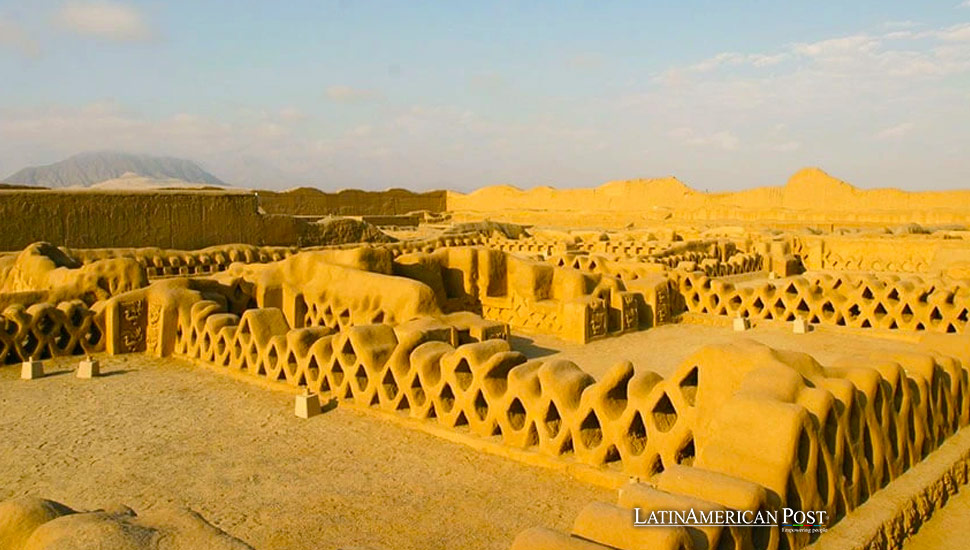Technology Unveils Secrets of Ancient Peruvian Adobe City

A team of Peruvian archaeologists has discovered skeletal remains and high-status ornaments at the pre-Hispanic site of Chan Chan, the largest adobe city in the Americas, located near the coastal town of Trujillo in northern Peru.
A team of Peruvian archaeologists has uncovered eleven individuals’ skeletal remains and ornaments indicative of high-status society at the pre-Hispanic site of Chan Chan. This ancient adobe city, the largest of its kind in the Americas, is located near the coastal town of Trujillo in northern Peru. The discovery was made during the research and conservation work on the perimeter wall of the Utzh An compound in the Gran Chimú Palace as part of the Special Archaeological Project Chan Chan Complex (PECACH) carried out by the Ministry of Culture.
The communication office of this archaeological area announced the discovery on Friday, emphasizing its significance in understanding the site’s historical and cultural context. The skeletal remains were found in the eastern section of the Utzh An compound’s perimeter wall. Sinthya Cueva, the director of the restoration project, reported that the remains were associated with three pairs of ear ornaments and two necklaces made of chakras (beads) and Spondylus shells, indicating that the individuals likely held high administrative positions in their society.
Technological Innovations in Archaeological Research
Technological Innovations in Archaeological Research the use of advanced technology in excavating and analyzing the Chan Chan site has been pivotal. Ground-penetrating radar (GPR) and 3D scanning are employed to map and explore the buried structures without causing damage. These methods allow archaeologists to gain insights into the ancient walls’ construction techniques and original forms, which is crucial for accurate restoration and preservation.
Guillermo Gonzales Méndez, the archaeologist responsible for the project, highlighted the importance of defining the construction technology and the original structure of the walls. “Restoring these walls is vital to preserve the monumental nature of Chan Chan,” he stated. Previous excavations using similar technologies have yielded significant discoveries, including 19 wooden sculptures and a ceremonial courtyard decorated with intricate mud reliefs.
Latin American Context and Technological Collaboration
This archaeological project is not just a local endeavor; it’s a global collaboration that advances the understanding of ancient Peruvian civilizations. The growing trend of incorporating modern technology in Latin American archaeological practices is a testament to the power of international cooperation. The adoption of cutting-edge technologies, such as LiDAR (Light Detection and Ranging), has been instrumental in mapping the dense urban layout of Chan Chan, showcasing the potential of technology in preserving our shared cultural heritage.
Moreover, the restoration project aims to preserve the site’s cultural heritage while promoting social conservation. This involves engaging local communities and promoting awareness about the importance of preserving historical sites. The Ministry of Culture’s initiative includes educational programs and public exhibitions, ensuring that technological advancements and archaeological findings are accessible to the broader public.
Future Prospects and Technological Challenges
As the restoration work continues, there is potential for more significant discoveries. The project is scheduled to restore 620 meters of the perimeter wall by November 26, 2024. Researchers are optimistic that further excavations will reveal additional insights into the social and architectural aspects of the Chan Chan civilization. The challenge lies in balancing the use of technology with the preservation of delicate archaeological materials.
The restoration process involves meticulous documentation and analysis. Advanced imaging techniques and software create detailed records of the site, aiding in restoration and future research. This systematic approach ensures that Chan Chan’s cultural heritage is preserved for future generations.
The success of the Chan Chan project highlights technology’s transformative impact on Latin American archaeology. It sets a precedent for future projects and emphasizes the importance of technological integration in uncovering and preserving ancient histories.
Cultural and Educational Impact
The findings at Chan Chan have significant cultural and educational implications. The use of technology in archaeological research not only enhances our understanding of ancient civilizations but also serves as a powerful tool for education and cultural preservation. The Ministry of Culture’s efforts to disseminate the findings through public outreach programs underscore the importance of making archaeological research accessible and engaging to the public, inspiring a new generation of archaeologists and historians.
Educational initiatives, such as workshops and interactive exhibits, are designed to inspire a new generation of archaeologists and historians. By showcasing the application of modern technology in uncovering ancient mysteries, these programs highlight the relevance and excitement of archaeological research in the digital age.
Looking Forward: Technology and Preservation
As the project progresses, technology integration in archaeological research continues to evolve. Innovations such as augmented reality (AR) and virtual reality (VR) offer new ways to experience and understand archaeological sites. These technologies could revolutionize how we interact with and learn about historical sites like Chan Chan.
The successful use of technology in the Chan Chan project is a model for other archaeological sites across Latin America and beyond. It demonstrates how modern tools can preserve and interpret ancient cultures, ensuring that their stories are told accurately and preserved for future generations.
Also read: Peru Implements New Regulations for the Science and Technology Sector
The discovery at Chan Chan, facilitated by advanced technological methods, marks a significant milestone in archaeology. It underscores the importance of technological integration in uncovering Latin America’s rich cultural heritage. As researchers continue to explore and preserve these ancient sites, the blend of traditional archaeological practices with modern technology promises to yield even more fascinating discoveries in the years to come.





